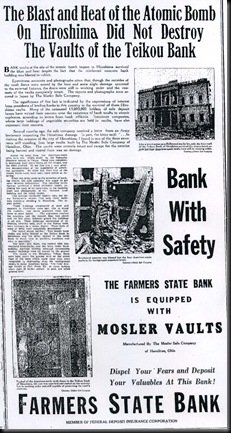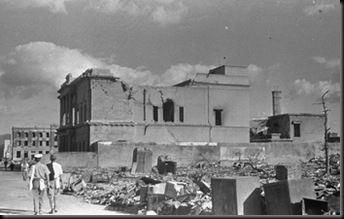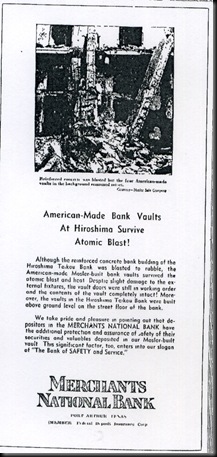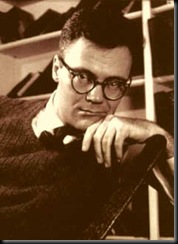“Your products were admired for being stronger than the atomic bomb."
-- Teikoku Bank Manager, Hiroshima, in a May 22, 1950 letter to the Mosler Safe Company of Hamilton, Ohio

In the annals of modern advertising, it is difficult to think of a more inappropriate example of product placement than the Mosler Safe Company's Hiroshima campaign. Less than a year after the August 6, 1945 atomic attack of that Japanese city, E.H. Mosler, president of the famous vault business, was crowing about his product having withstood the destructive force of the A-bomb. The safe magnate explained in press accounts[1] that he had become aware of the vault’s awesome endurance feat courtesy of a U.S. Army lieutenant who had been surveying the damage. This unnamed officer wrote the company a glowing letter (no doubt punched up by Mosler’s copy writers) sometime in early 1946 describing what he had seen:
…In visiting the remains of the City of Hiroshima, I found in one of the three structures still standing, four large vaults built by the Mosler Safe Co. of Hamilton, O. The vaults were entirely intact and except for the exterior being burned and rusted there was no damage. Across the room from the American-made safes were two vaults made by the Takeucho Co. located at Tokyo. These were completely destroyed, their doors blown off the hinges, and the sides crushed. To me this was a very positive demonstration of the superiority of American equipment. No other test than that of the atomic bomb could have been more severe or exacting.

The Teikoku Bank opened in 1925 as the Mitsui Bank with the same vaults that eventually survived the Hiroshima blast. The two-story structure was 360 meters from the hypocenter of the bomb and all that was left was its facade—and the Mosler vaults. At the time of the attack (8:15 a.m.), the bank had six night duty staff and twelve or thirteen female employees working there. None survived.[2]
After receiving the missive from the lieutenant, Mosler commissioned an official report to better document (and exploit) the durability of the vaults. The report stated, in part:
Those buildings constructed of steel and concrete in Hiroshima were best able to stand the explosion and hence protected their contents to some degree. …The explosions cracked the exteriors, tore the cement floors into pieces and the fire which followed gutted the buildings of all else. Those buildings constructed of reinforced concrete only, such as the Teikou [sic] Bank, were damaged to a larger degree. Those built of wood or brick were completely demolished.
Two Mosler bank vaults, one being located at the Teikou [sic] Bank in Hiroshima and the other located in the Geibi Bank in Kure, were in excellent condition and were in operation.It did not take long for the amazing atom age achievement to find its way into local bank advertisements. For even though the Russians did not yet have the Bomb, Americans in 1946, were, evidently, concerned about their valuables surviving such an assault. At least that is what the banking industry claimed in the same American Banker issue that was among the first to promote the Hiroshima vault story: “Many of the estimated 13,000,000 holders of safe deposit boxes have voiced their concerns over the resistance of bank vaults to atomic explosion, according to letters from bank officials.”[3] These newspaper ads promoted their respective banks’ use of Mosler vaults as a selling point to potential customers. Mosler undoubtedly welcomed and approved of this added publicity because their own photographs were used in the promotions.

About the same time that the Teikoku Bank was being rebuilt around the still-standing vaults in Hiroshima, Mosler received another unsolicited tribute to its sturdy craftsmanship. The May 22, 1950 letter from the enthusiastic bank manager is noteworthy for how blithely he mentions the victims of the bomb before getting on with the real purpose of the correspondence—fawning praise:
The Teikoku Bank Limited
Kawayacho, Hiroshima Japan
May 22, 1950
Sir,
We consider it our great honour to inform you that The Teikoku Bank, the successor to the Mitsui Bank, had in 1925 when its Hiroshima branch was newly built dared to set two vault doors made by your Hamilton Factory.
As you know in 1945 the Atomic bomb fell on Hiroshima, and the whole city was destroyed and thousands of citizens lost their precious lives. And our building, the best artistic one in Hiroshima, was also destroyed. However it was our great luck to find that though the surface of the vault doors was heavily damaged, its contents were not affected at all and the cash and important documents were perfectly saved. The superiority of your goods is completely verified as truly told to the whole world in the American Bankers [sic], the July 13th issue of 1946. Your products were admired for being stronger than the atomic bomb.
Since then about five years have elapsed. The building and doors of the vault have been completely repaired and we have started our business on the first of the month. Recently many tourists have come to see our building and when we show them your vault we proudly explain to them how strong they were against the atomic explosion.
We hereby wish to have a letter of congratulations and some souvenir to celebrate our opening business at out old office. We shall appreciate it as our utmost honour, and we believe it will do much to keep and promote a good will relation for the long future.
Yours very faithfully
The Teikoku Bank Limited
T [illegible]
Manager, Hiroshima Branch.[4]
Not surprisingly, Mosler used the testimonial in a fresh promotional push. The “Hiroshima” chapter of the bank’s long history proved to be so irresistible to its PR department that they trumpeted it for at least the next decade. One such advertisement caught the eye of poet Robert Lowell in Boston, Massachusetts in 1960.[5] The crassness of the campaign (captioned “The Hiroshima Story Comes to Life with a Bang”)[6] inspired Lowell to include a line about it in his most famous poem, For the Union Dead:
…on Boylston Street, a commercial photograph / shows Hiroshima boiling / over a Mosler Safe, the ‘Rock of Ages’ / that survived the blast.

Mosler’s advertising may have repulsed an esteemed American poet, but it impressed the hell out of the U.S. government. Indeed, the company was kept so busy during the Cold War that it created a special “protective construction” division just to accommodate the various contracts it won. Among Mosler’s work product during this period was a specially designed vault for the Declaration of Independence, Constitution and Bill of Rights and a 25 ton door to the then top secret congressional bunker at the Greenbrier Hotel in West Virginia.[7]
As it turned out, the economy of the 21st century was the one thing that Mosler could not withstand. In 2001, after 153 years in business, the company’s Hamilton, Ohio headquarters closed its doors.[8] The business’s impressive metal handiwork can still be seen at the Greenbrier and at many other locations if not in Hiroshima. The Teikoku Bank was converted into a bakery in 1967. Mosler and the atomic bomb, though, will forever be linked in the twin vaults of history and poetry.

[1] The first report of the Mosler Safe Company’s product surviving the Hiroshima blast was published in the Hamilton (Ohio) Journal-Daily News (the hometown of Mosler Safe Co.) on July 10, 1946. The American Banker published a story on the atom-defying vaults on July 13, 1946 (page 8). Mosler provided the publication with photographs illustrating the bomb damage to the Teikoku Bank and the working order of the vaults. Subsequently, the story was picked up in other newspapers such as the Fayette County (Iowa) Leader (September 12, 1946).
[2] See: Hiroshima Virtual Tour.
[3] “Will U.S. Vaults Resist Atom Bombs? Hiroshima Experience Proves They Do,” The American Banker, July 13, 1946 (page 8).
[4] “The History of Mosler,” Mpulse (Mosler company magazine), 1973, page 30.
[5] Paul Mariani, “Lost Puritan: A Life of Robert Lowell” [New York: W.W. Norton, 1994], p. 283. According to Mariani, Lowell worked for several months on “For the Union Dead” beginning in January of 1960. He read it publicly in June of that year for several thousand people at Boston’s Public Garden. The poem received “thunderous applause.”
[6] Jeffrey Meyers, “The Mosler Safe in Lowell’s ‘For the Union Dead,” American Notes and Queries, Volume 3, issue 1, 1990, page 23. Meyers reports in his excellent article that the Mosler Archives did not retain a copy of the ad that Lowell saw on Boylston Street, but they were able to confirm the caption for the photograph: “The Hiroshima Story Comes to Life with a Bang.”
[7] Tom Vanderbilt, Survival City: Adventures Among the Ruins of Atomic America [Princeton, NJ: Princeton Architecture Press], p. 137. Pauline Maier, American Scripture: Making of the Declaration of Independence [New York: Vintage Books], p. ix.
[8] Mike Boyer, “Mosler Slams Door on 300 Workers,” Cincinnati Enquirer, August 4, 2001. As of 2010, a vestige of the company remains active in the United Kingdom.


111 comments:
Post a Comment